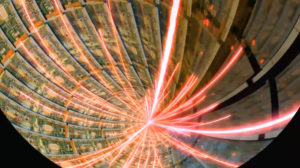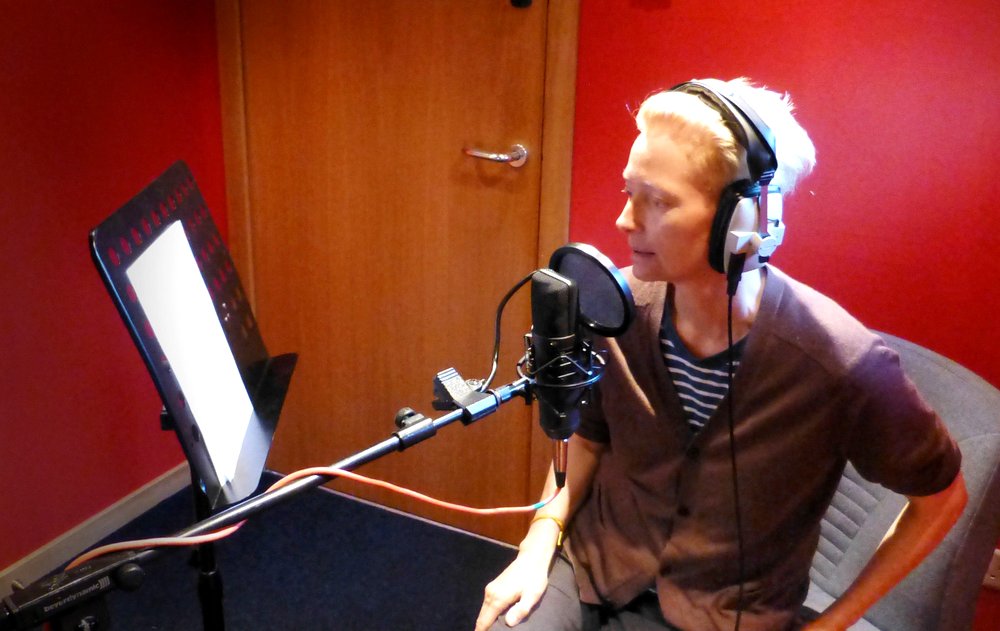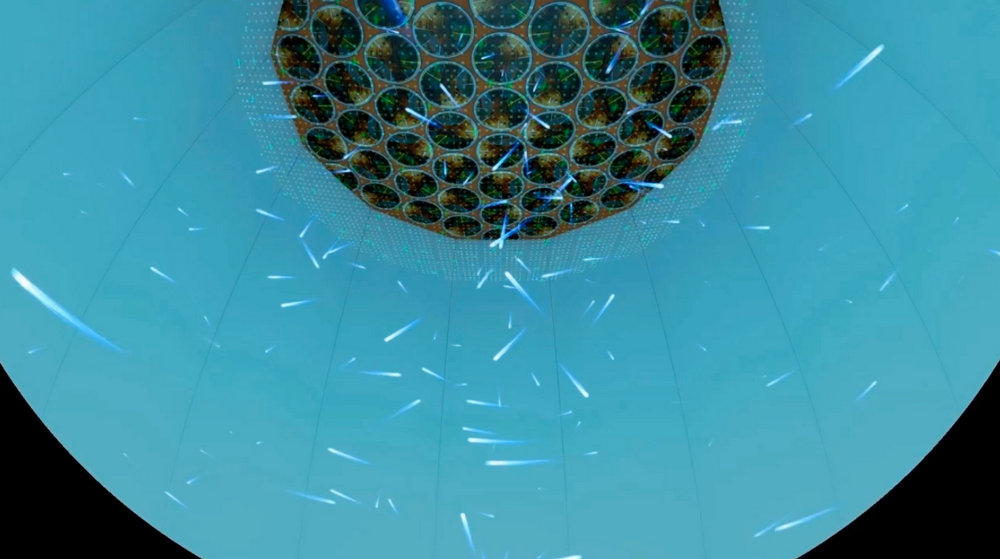
Measurements of galaxy rotation by astronomer Vera Rubin, who is shown in this rendering peering through a telescope, are described in a new planetarium show. (Credit: “Phantom of the Universe”)
From the journey of protons racing through the world’s largest particle collider in Europe to up-close views of the Big Bang and emergent universe, and the nearly mile-deep descent to an underground experiment in South Dakota, a new planetarium show is designed to immerse audiences in the manifold search for dark matter.
Michael Barnett, a physicist at the Department of Energy’s Lawrence Berkeley National Laboratory (Berkeley Lab), imagined these scenes coming to life inside planetarium domes around the planet while working as an outreach coordinator at CERN laboratory in Switzerland six years ago.
Visualizing the Invisible
An obvious challenge for the production, “Phantom of the Universe,” is that the star of the show—dark matter, which we have so far detected only through its gravitational effects though it makes up an estimated 85 percent of the total mass of the universe—is invisible and we don’t yet know what it’s made of. Researchers are scanning the night sky and designing ultrasensitive underground particle detectors in hopes of solving its mysteries.
A video trailer for the “Phantom of the Universe” planetarium show.
“I wanted to convey the excitement of what’s going on in research,” Barnett said, “to show how many things we’ve learned about dark matter, how we know it’s really there, and to show how we’re trying to figure out what it is.”
He discussed the concept with colleagues, including those who worked at universities with planetariums, and the production team began to take shape. Many people put in a lot of volunteer hours to see it through, said Barnett, who served as executive producer.
“The planetarium dome was just perfect for many things we wanted to do,” he said. “You could think about protons going around the walls of the planetarium and circling behind you, and also imagine particle collisions happening above you and raining down the walls of the planetarium,” added Barnett.

An illustration of a particle collision at CERN’s Large Hadron Collider. (Credit: “Phantom of the Universe”)
Besides the ability to display imagery above and all around you, planetariums are also a powerful outreach and educational platform, drawing about 120 million visitors each year. “Phantom of the Universe” will be offered free of charge to planetariums around the world.
Star Power
Joao Pequenao of CERN’s Media Lab, a former research specialist at Berkeley Lab, directed the production. It features narration by Academy Award-winning actress Tilda Swinton and sound effects by Skywalker Sound, the studio responsible for the hum of lightsabers and whine of spaceships in the “Star Wars” films. Carey Ann Strelecki, who served as senior research consultant on the Academy Award-winning documentary film “An Inconvenient Truth,” handled the writing and production work.
The 25-minute production was completed in mid-September. A German-language version will air Oct. 18 during a science festival in Vienna, Austria, and a French-language version is also planned.
Technical Challenges
While planetarium shows offer a unique, engaging visual experience, they can be technically challenging to produce.
Barnett had worked with Pequenao on other short films, including a miniseries that featured computer-rendered animations of the ATLAS experiment, but the planetarium production was new turf for them both.

Work in progress: These notes were used to help plan the order of segments in the planetarium show. (Credit: Joao Pequenao/CERN)
Pequenao worked with a small team of animators in Valencia, Spain, to design and build the film’s computer-generated sequences.
“We built huge and complex 3-D scenes. The rendering process is very intensive and slow, so you need to have a lot of computers available to distribute these calculations,” said Pequenao.
Just as CERN distributes a huge pipeline of experimental data from its particle physics experiments to many locations for data analysis, Pequenao organized several “render farms”—in Valencia, Spain, the University of Texas at Arlington, and Michigan State University—to distribute and process the data for the planetarium show’s digital animations.
It can take weeks and even months to completely render an animated sequence that is only a couple of minutes in duration, Pequenao said.
Modern planetariums typically have five or six projectors that work together to display a show, and the sequence of projectors are not all alike so there is a challenge in making a “one-size-fits-all” show, he also said.

A computerized rendering showing the distribution of dark matter as two galaxy clusters collide. (Credit: “Phantom of the Universe”)
Viewing a planetarium show on a standard monitor provides a distorted picture, so the production team made several visits to planetariums in the U.S., U.K., and France to test out new footage.
“We got input from experts at the planetariums, who helped us tweak it as we went along,” Pequenao said. “It took us awhile to really understand the medium we were working on. That’s why you have to ‘test drive’ it in a planetarium.”
Physics and Finesse
Barnett and George Smoot, a Nobel Prize-winning physicist at Berkeley Lab and UC Berkeley, along with Kaushik De at University of Texas at Arlington and Reinhard Schwienhorst at Michigan State University, engaged in a sort of “ping-pong match” with other members of the production team to figure out “what was beautiful but needed a little tweaking” to make the physics more accurate and effective on screen, Pequenao said.
The show pays homage to physicists Fritz Zwicky and Vera Rubin, whose measurements of light in galaxy clusters and of galaxy rotation, respectively, provided key evidence for dark matter’s existence.
“A huge challenge were the astrophysics scenes representing dark matter in space,” Pequenao said. “We have to simulate the Andromeda Galaxy, and show where dark matter has to be present.”

A rendering of the elevator descent toward an underground dark matter experiment in South Dakota called LUX. The planetarium show also featured actual footage of a tunnel leading to LUX. (Credit: “Phantom of the Universe.”)
The production includes camera footage taken during a visit to the Large Underground Xenon (LUX) dark matter experiment at the Sanford Underground Research Facility (SURF) in South Dakota, including a ride on a rail car through a tunnel.
Behind the scenes
A highlight for Barnett was the opportunity to meet and work with Swinton, who impressed him with her narration of the BBC documentary series “Galápagos.” In June, Barnett traveled to a small studio in the Scottish Highlands to witness Swinton recording the narration for “Phantom of the Universe.”
“The scientific process and filmmaking are both creative processes,” Barnett said, “and connecting art to science is what we’re trying to do with this film. Our purpose here is to get people excited about physics and cosmology.”

Actress Tilda Swinton is pictured here in a studio in Scotland as she records the narration for “Phantom of the Universe.” (Courtesy: Michael Barnett/Berkeley Lab)
Pequenao said, “Most of the universe is of a mysterious nature and we are only starting to explore it, and understanding this substance known as dark matter will fundamentally change the way we perceive the universe for decades to come.”
He added, “My moment of truth will be when I go to a screening and I see kids and teenagers excited about understanding dark matter.”
The collaboration that created “Phantom of the Universe” included Berkeley Lab, University of Texas in Arlington, and Michigan State University, with assistance from the Instituto de Física Corpuscular (IFIC), a joint center of the Spanish National Research Council (CSIC), and València University in Spain.

A simulation of particles interacting with liquid xenon inside the LUX experiment. (Credit: “Phantom of the Universe”)
The production was supported by the Department of Energy’s Office of Science, National Science Foundation, the ATLAS Experiment, Lawrence Berkeley National Laboratory, Michigan State University, the University of Texas at Arlington,
CERN, the U.K.’s Science & Technology Facilities Council, Institute for Corpuscular Physics (IFIC) in Spain, the Institute for High Energy Physics of the Austrian Academy of Sciences (HEPHY), the Natural History Museum Vienna, and the German lab DESY.
More information about “Phantom of the Universe”: http://phantomoftheuniverse.com/.
# # #
Lawrence Berkeley National Laboratory addresses the world’s most urgent scientific challenges by advancing sustainable energy, protecting human health, creating new materials, and revealing the origin and fate of the universe. Founded in 1931, Berkeley Lab’s scientific expertise has been recognized with 13 Nobel prizes. The University of California manages Berkeley Lab for the U.S. Department of Energy’s Office of Science. For more, visit www.lbl.gov.
DOE’s Office of Science is the single largest supporter of basic research in the physical sciences in the United States, and is working to address some of the most pressing challenges of our time. For more information, please visit science.energy.gov.